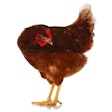
Across Asia, highly pathogenic avian influenza (HPAI) virus is being detected for the first time this winter. While Cambodia, Israel, Japan and Taiwan have each reported one or more outbreaks, officials in South Korea have announced the introduction of strict disease control measures. There, two virus variants have been identified, and the number of suspected farm outbreaks has already reached 20.
Over the past few weeks, HPAI has returned to the poultry populations of South Korea, Israel and Taiwan following a hiatus of varying lengths.
In South Korea, the H5N1 virus variant was detected for the first time in early December after an absence of seven months.
According to the official notification from the national veterinary authority to the World Organisation for Animal Health (WOAH), the first to be affected was a flock of around 22,000 head of poultry at a farm in North Jeolla.
Just two days later, the H5N6 virus variant was identified in South Korean domestic birds for the first time in more than three years.
Within a few days, outbreaks linked to this variant were confirmed at eight locations, impacting almost 514,000 poultry in three provinces. Six of the affected premises were in North Jeolla, and one each in South Jeolla and South Chungcheong. All these outbreaks appear to be in the west of the country.
South Korea introduces tougher disease controls
By mid-December, the agriculture ministry had announced it was increasing measures to control the spread of HPAI, reported Korea Times.
The minister confirmed the inspection and surveillance of poultry farms was being enhanced to ensure compliance with quarantine regulations. He also urged visitors to wild bird habitats not to visit poultry farms.
The latest updates from South Korea’s agriculture ministry put the number of confirmed HPAI outbreaks on the nation’s poultry farms at 18 (as of December 16), with two more suspected. Affected have been 11 flocks of laying hens, six of meat ducks, two of broiler breeder chickens and one of ducklings.
Each reported outbreak is followed by a 24- and 36-hour period of standstill in the surrounding area. This involves a halt on all movements to and from poultry farms and related businesses, such as feed mills and slaughterhouses, allowing time for the cleaning and disinfection of vehicles and premises.
As a result of what the ministry describes as the “serious situation,” inspections are also being increased at South Korea’s large poultry farms.
Furthermore, for a limited period, preventative culling is being extended to cover all farmed ducks within 1km of a confirmed outbreak. Also with the aim to prevent horizontal transmission of the virus, the former policy of culling all other poultry within 500 meters remains in place. The ministry retains the option to amend or extend these measures after the current period expires.
So far, the ministry reports only minimal impacts on the national supply of eggs and poultry meat. However, officials are preparing to ensure supplies and market prices remain stable.
Based on WOAH reports, South Korea’s last HPAI outbreak wave involved more than 8.8 million domestic poultry at 122 locations between November 2022 and April of this year.
Avian flu returns to poultry flocks in Israel, Taiwan
Following a nine-month hiatus, the H5N1 HPAI virus serotype was detected in an Israeli poultry flock in the last week of November.
According to reports submitted to WOAH, three farms have confirmed cases, which have involved a total of 65,400 commercial birds. The first two outbreaks affected turkeys in Jerusalem and Hadarom (South District). The poultry type was not specified at the third premises, which was located in Haifa.
In Taiwan, the first of the new HPAI “season” outbreaks involving the H5N1 virus variant began November 22.
Based on information supplied to WOAH, this followed directly after the previous series was closed, and involved a farm with 16,100 laying hens in Yunlin County.
More outbreaks on farms in Japan, Cambodia
Two further outbreaks linked to the H5N1 HPAI virus have been confirmed in poultry flocks. This brings the total to four since the avian flu season started again one month ago.
Latest premises to be hit by the disease were two egg farms, comprising around 23,000 and 45,300 layers, located in the Kyushu and Kanto regions, according to the latest WOAH report.
The earlier outbreaks were in the same regions — located on the southern main island of Kyushu and in the Greater Tokyo area on the largest island of Honshu.
Up to the latest outbreak that started December 2, 178,626 hens have been impacted by the current outbreak in Japan.
A second HPAI outbreak linked to the same virus serotype has occurred in Cambodia.
Based on WOAH notifications, the latest cases were found in a village flock comprising around 350 backyard poultry. It was located in Battambang, a province in the northwest of the country — far from the first outbreak detected in the southern province of Kampot.
Earlier this month, the H5N1 HPAI virus serotype was detected for the first time in the 2023-2024 season in Japan and Cambodia.
To WOAH, the animal health agency of India has declared previous HPAI outbreak series in Bihar and Jharkhand resolved. Two outbreaks were confirmed in poultry in each of these adjacent eastern states earlier this year.
HPAI detected in wild birds in Asian states
Over the past few weeks, wild birds in China and South Korea have tested positive for HPAI for the first time this winter.
According to notifications to WOAH, South Korean authorities have identified two virus serotypes circulating in wild species — as they have also recently in domestic poultry.
The H5N6 virus variant was last detected in the country in April 2018. That was until the first week of December, when three cases were reported to WOAH. One case was found in each of the central-southern provinces of North Gyeongsang, South Gyeongsang and North Jeolla.
At the end of November, the presence of the H5N1 virus variant in South Korea’s wild bird population was reported, following an absence of less than three months.
First to test positive for this serotype was a wild duck in North Jeolla. Subsequent reports to WOAH indicate a further three cases in swans, which were all found in North Gyeongsang.
In the People’s Republic of China, the H5N1 HPAI virus has been detected in wild birds in Fujian for the first time. According to the latest official notification, seven birds of unknown types were found dead in a natural park in Fuzhou city in the southwestern province during the first week of December.
Meanwhile, following a near 12-month hiatus, the same virus serotype was detected around the same time in the Hong Kong Special Administrative Region.
Testing positive was a sample of wild bird droppings at a nature reserve, as part of the surveillance program in the territory. The WOAH report indicates there are no poultry farms within 3km of this location.
Subsequent reports confirm two more detections of the virus in the same area — in a second sample of droppings, and the carcass of a wild duck that is a winter visitor to the territory.
According to the latest notification to the same agency from Japan, a further 27 wild birds have tested positive for the H5N1 HPAI virus. Found across the islands of Hokkaido, Honshu, Shikoku and Kyushu, the individuals were of several different species.
Philippines province monitors wild birds
Meanwhile, in the Philippines, the provincial veterinary authority in Negros Occidental has begun monitoring the movements of migratory birds. Generally, these wild species are the sources of HPAI viruses afflicting domestic poultry.
This province in the Western Visayas region is free of HPAI, according to the Philippine News Agency. However, the authority aims to protect this important poultry-producing province from the spread of infection. For around one year, a ban has been in place on the import of live poultry and their products from other parts of the country. Hatching eggs and day-old chicks can only enter the province if accompanied by a veterinary certificate.
Latest human cases confirmed in Cambodia
Earlier this month, the World Health Organization (WHO) was informed by the Cambodian health authority about two human infections with the avian influenza A(H5N1) virus.
Both patients were from the same village in Kampot province in the south of the country, and had contact with sick or dead poultry. One of the cases — a 21-year-old woman — has died, while a 4-year-old girl was receiving hospital treatment. The patients did not have contact with each other.
Around the same time these human cases were identified, the H5N1 HPAI virus was detected in village poultry in Kampot.
These latest cases bring to 246 the number of lab-confirmed cases of infection with this virus reported in the Western Pacific Region to WHO since 2003. Worldwide over this period, 880 cases in 23 countries have been reported to the WHO.
View our continuing coverage of the global avian influenza situation.
















